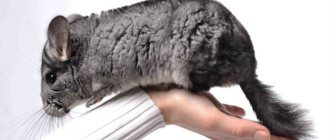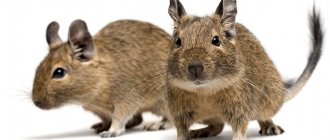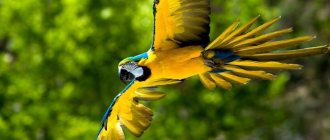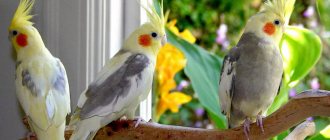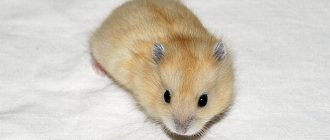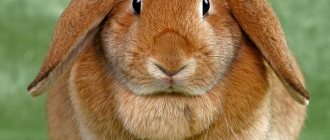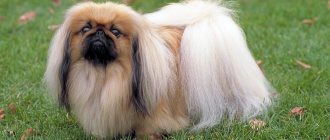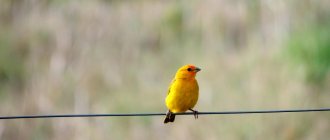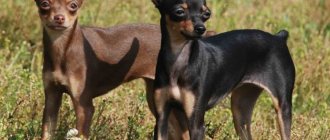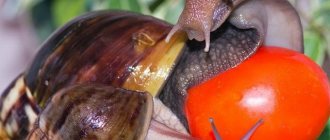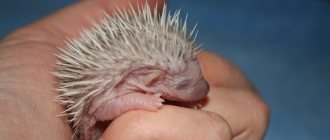Description of the Chilean squirrel
The rodent has a rounded head, a short stocky neck, a flat nose, and an arched back. The animal's front legs are shorter than its hind legs. The fur on the tail ends in a small, stiff brush. The squirrel's hair is coarse, its color is gray-brown, it may have an orange tint, and on its belly it is yellow-cream. The length of the animal including the tail reaches 40 centimeters, the weight of an adult is 300 grams. However, when keeping a rodent in captivity, the mentioned parameters will be less. Many will probably wonder how long the animals in question live. In fact, the squirrel's age is short-lived. As a rule, the average life expectancy of nimble beauties does not exceed 4 years. But “under the owner’s wing” these periods increase. The squirrel degu is no exception. How long does an animal live at home? With proper care, your squirrel will delight you for at least 6-8 years.
What kind of animal is this and how to choose?
Adult Chilean squirrels rarely reach 40 centimeters in length and weigh 200-300 g. Distinctive features of the rodent are a small, round, slightly elongated head, wide-set eyes, a flattened nose, rounded ears, a short, thick neck, a back with a hump. The hind legs are longer than the front ones, and the tip of the tail is tasseled. The hard, dense coat can be chestnut-gray or yellow-brown. 16 teeth grow throughout your life.
To decide whether a degu is suitable for you as a pet, you need to familiarize yourself with the nuances of choice and content:
- Age. You need to take a Chilean squirrel into your home after finishing feeding with mother's milk - at 1.5-2 months. At this time, there will be no more problems with catering. In addition, babies have time to learn the habits and skills of adults and acquire stable immunity.
- Parents. It is important that the animals are healthy, well-groomed and kept in good conditions.
- Parents' diet. The offspring of malnourished animals are susceptible to diabetes.
- Parental behavior. It’s great if adult degus are not afraid, but study strangers.
- Appearance of the cub. The coat should be smooth and free from bald spots, the eyes should be dry and shiny.
- Location of the male. Boy animals from the age of one and a half months must live in a separate cage with their father, and girls with their mother. Otherwise, early fertilization may occur.
- It is not recommended to keep cheerful rodents alone who get along well with each other. A pair or flock of degus will give owners a lot of pleasure from watching them play.
Squirrels
Survival
Everyone knows that if a predator grabs a lizard by the tail, it will simply throw it away and subsequently grow a new one. Also, crayfish easily part with their limbs. But a degu squirrel, when sharply tugged (or strongly held) by the tail, loses the skin covering it. The skin is easily removed (just like a stocking) from the musculoskeletal base. In this case, the leather case remains with the predator, and the animal itself escapes death. Subsequently, the squirrel chews off the tail. The wound heals quite quickly. True, then it becomes uncomfortable for the animal to jump and climb, but such physiology contributes to the survival of this species in nature.
Origin and description of the species - all about degu
Degus live in the territories of several countries: Bolivia, Peru, Argentina. But the highest population density of these rodents is observed in Chile, where they inhabit the entire western part of the Andean Cordillera.
Local farmers have long known the harmful animal, which eats crops, raids food granaries and causes significant damage to agriculture.
In the scientific classification, degus belong to the eight-toothed family, which unites 13 species of rodents. But the Chilean squirrel has its own distinctive features:
- degu in nature goes out for food during the day, while other representatives of this family do this at night or at dusk;
- all feed exclusively on tubers, young shoots or bark, and degu prefers to look for prey in the thickets of cultivated plantings;
- Most eight-toothed squirrels dig extensive underground labyrinths, but the bush squirrel is not very successful at this.
This is interesting! In general, the degu genus includes 4 representatives - Octodon bridgesi, Octodon lunatus, Octodon pacificus, Octodon degus. But only Chilean proteins have been sufficiently studied.
Sense organs
The degu squirrel has poor eyesight. Thanks to the location of their eyes, rodents have access to a wide view, which helps them respond to danger in a timely manner. However, this feature does not allow one to clearly perceive objects located at a distance. But this animal’s hearing is very acute. Squirrels communicate with each other using high-frequency sounds. The human ear does not perceive this range. Rodents easily distinguish the sounds made by animals in moments when they are subject to aggression from the enemy, which also contributes to survival. In addition, the Chilean squirrel has a highly sensitive sense of smell. When moving, she always holds her nose up, thanks to which she is able to capture the most subtle odors that are in the air. This feature allows the rodent to navigate in nature.
The next sensory organ of the squirrel is the vibrissae. These are thin hairs that act as organs of touch. Thanks to them, the rodent can perfectly navigate in space even at night. The vibrissae are extremely sensitive; when they come into contact with some obstacle, they send signals (nerve impulses) to the brain, due to which the animal receives an idea of the objects around it. Reacting to the slightest vibrations in the air, these hairs allow the squirrel to estimate the distance to a particular object.
Now let's move on to the taste organs. They are very developed in rodents. Thanks to this, the animal avoids the fate of being poisoned, because it will never eat food with poisonous impurities. The Chilean squirrel simply will not eat foods with which it has a negative experience.
Rules for keeping degus
Despite the relatively small size of the animals, they require sufficient space. This is explained by the mobility of proteins. You should prepare in advance a spacious cage measuring at least 60x60x60 cm. The ideal size is 120x60x100 cm. The structure should be made of stainless steel.
Other materials, such as wood or plastic, are not suitable for one reason: the animal can chew them with its sharp teeth in a matter of minutes.
It is advisable to make 2 or 3 levels inside, connecting them with ladders. A special room must be provided in the cage for the animal to spend the night. A small house can serve as such a place. In addition, you need to place a tray filled with wood shavings in the cage. It is advisable for her to cover the bottom of the cage as well. If this is not available, you can use pressed corn cobs or white sheets of paper.
Chilean degu squirrels love to hide in various shelters, so it is necessary to provide such places for them. Many owners place clay pots in the cage, small stones, tree roots or branches, along which rodents happily run. Animals need plants to sharpen their teeth on them, so it is necessary to periodically add new portions of tree branches to them. It is also recommended to install several shelves that will attract the attention of an inquisitive animal. To prevent the animal from being injured, these structures should be secured securely.
In nature, squirrels are often on the move. In cages they do not move as intensely, so a special wheel is installed in them. Moving inside it, proteins expend energy. It is necessary to take care of the placement of feeders, of which there should be several, as well as a reservoir with fresh water.
The Chilean squirrel does not like to be in direct sunlight, so the cage must be placed in a shaded place. It is necessary to ensure that the animal’s home is not located in a draft.
Reproduction
Reproductive maturity of the female occurs at 12 weeks, for the male at 16. The degu squirrel at home is able to reproduce throughout the year, and in the wild, in the southern part of their habitat, from the end of February to November. In the northern regions this period is somewhat shorter. The duration of pregnancy for the Chilean squirrel is 87-93 days. Usually from 3 to 10 babies are born. Squirrels are covered with fur, have developed teeth and partially open eyes. The average weight of a cub is 14 grams.
The female feeds the young with milk for 5-6 weeks, until the squirrels reach a certain degree of independence. The peculiarity of female Chilean squirrels is that immediately after giving birth they are ready for a new mating. The family of these rodents is distinguished by the division of responsibilities and developed social behavior. Before giving birth, the female obtains food on her own and protects her habitat. After the birth of the offspring, she continues to obtain food, and the protection of the family falls on the male.
How long do Degus live?
Degus are domestic rodents, and their fate is to become prey to forest predators.
Plants treated with chemicals often cause the death of Degus. Due to these reasons, it is quite rare for wild Degus to live a long life. Only half of Degus survive to one year, and hardly every hundredth animal reaches its second birthday. 4 years is the maximum allotted to wild Degus.
Degus kept in captivity have had better luck. Voracious predators do not encroach on their lives, and the food is balanced and does not contain harmful impurities. Of course, at home they also face danger in the form of a cat, a ferret or an inattentive owner, but it is disproportionately less than that of their wild relatives.
With good care, pets live on average 5-7 years, and some specimens can celebrate their tenth anniversary.
Degu longevity depends on many factors: balanced food, mobility, number of births in females. But 5 years is a rather advanced age for a rodent, no matter how carefully it is cared for, and a 10-year-old pet is like a very old man. The basis for a long life of a Degu in captivity is proper nutrition.
Home for the Chilean squirrel
Building a house for your pet is very important, because the animal constantly stays in it. He should feel cozy and comfortable. The cage must have good ventilation and be spacious (up to 1 square meter in area). The height of the walls is at least 70 cm. Plastic cages are not suitable for keeping these rodents, since at one point the squirrels will gnaw through the bars and scatter around your apartment. The house should be positioned in such a way that it is not exposed to direct sunlight. In addition, degus do not like irritating strong odors, music, running TV and high temperatures. It is not recommended to take the cage outside, as these animals are not adapted to our climate.
Degu in the wild
Chilean squirrels are social animals, as they live in small groups, which include no more than 2 males, about 5 females, and a dozen cubs. Each such family occupies an area of about 200 square meters. Habitats are characterized by the presence of a food supply, as well as a network of underground tunnels. Each family makes sure that strangers do not appear on their territory.
Lifestyle
Living in natural conditions in groups, the animals do an excellent job of digging holes, as well as maintaining them. When digging holes, the animals line up in a chain, after which they pass the land to each other. This way the soil appears on the surface. This method of digging holes allows animals to create fairly long tunnels underground.
This animal spends quite a lot of time underground, while the animals constantly feed and make provisions for the winter. Reserves are made either in burrows or buried in the upper layers of the soil. The basis of the diet of such animals is:
- Various herbaceous plants.
- Tree bark.
- Green leaves.
- Seeds of various origins.
- In winter, dry herbs and leaves.
As a rule, a female becomes pregnant once a year, although there are cases where she becomes pregnant twice. Pregnancy lasts almost 3 months, after which from 1 to 10 cubs are born, weighing no more than 15 grams each. While in captivity, a female can become pregnant several times. Since the female can become pregnant again after giving birth, it is better to remove the male immediately.
For 2-6 weeks, the offspring mainly feed on mother's milk, but after 2 weeks solid food begins to appear in their diet. After 3 weeks, the small animals begin to leave the hole on their own.
If the young try to leave the shelter early, the parents drag it back into the hole. Males do not stand aside and help females raise their cubs. They constantly carry fresh grass into the hole. Before the onset of sexual maturity, the young animals form same-sex groups, and after 4 months the young animals are able to mate.
This animal is mainly diurnal, with the greatest activity occurring in the morning and evening.
Natural habitats
Since this is a South American rodent, it lives in countries such as Peru, Argentina, Bolivia and Chile. Its favorite places are rocky areas, abundantly overgrown with shrubby vegetation.
It is important to know! Adult rodents mark their territories with urine. They communicate with each other in various ways, including with the help of sounds, of which there are at least one and a half dozen.
These animals try to avoid direct sunlight, so during particularly hot periods they prefer to stay in their shelters.
To feed, Chilean squirrels appear on the surface of the ground early in the morning or late in the evening, when the sun's rays are not so active. In addition to the heat, these animals are afraid of falling into the clutches of their natural enemies, and there are many of them.
These rodents often appear in fields, causing damage to agricultural crops, and are therefore considered pests of cultivated plants. Eating plants in the fields, animals often die, poisoned by various chemicals.
Life with Degus/Pros and Cons/We have a new addition
Caring for the Chilean squirrel
Pebbles, roots and tree branches should be placed inside the home, because the degu loves to chew bark and wood. They also like different hiding places. You can put a wheel in the cage, because these are very active creatures, they need to constantly move. In addition, you will need to provide bowls for different types of food. It is better to fix the drinking bowl on the wall.
It is better to use compressed corn cobs, white paper or rags as bedding. Sawdust is not recommended because rodents often have an allergic reaction to it. Cleaning should be carried out when soiled, but at least once a month. Once a day you need to place a bath of sand, in which squirrels love to swim. After the procedure is completed, it should be removed, otherwise the rodent will use the reservoir for other purposes (instead of the toilet).
How long do degus live?
A degu is a fluffy animal that looks like a hamster, dormouse, or chinchilla. Its body length is 9-20 cm, its tail is more than 10 cm, with a fluffy tassel at the end. Rodents have rounded ears and very sensitive hearing aids. The body is covered with thick fur. The degu, like other rodents, feeds on plant foods: grass, flowers, soft acacia shoots, seeds and roots. It is often called the Chilean squirrel. He lives in the mountainous and lowland regions of Chile, Argentina, Bolivia, and Peru. Individuals of the Octodon species build burrows for themselves, in which they hide from danger and spend the night.
Bridges' degus and moontooths prefer rocky slopes. They find refuge in rock crevices. Dormouse degus are found in beech forests. They take refuge in small burrows that they build under the roots of trees. Sometimes squirrels find a home in some old nest. There are also Pacific degus. A humid climate is preferable for it. From danger he hides under cacti and acacia bushes. With good home care, chinchillas can live more than 10 years, guinea pigs 7-8 years, dormouse 2-4 years. How long do degus live? How to care for them?
Squirrel degu: what to feed?
In nature, these animals feed on dry grass, tree bark, roots and seeds of plants. This is what you should base your pet’s diet on. Pet stores sell special food adapted for Chilean squirrels. If you are not satisfied with this option, then you can make the mixtures yourself. They must include various grains, oatmeal, cereals, and dried peas. In addition, hay is a very important component of the rodent diet, so it should always be present in the feeder. The degu should also eat at least 50 g of fresh green grass per day. The Chilean squirrel happily eats apples and pears, carrots, radishes, and cauliflower. However, before giving vegetables and fruits to the animal, they must be thoroughly washed in running water and wiped dry. Nuts and sunflower seeds are considered a special treat, but you should not overuse these foods, as your pet will develop health problems due to obesity.
Care and maintenance at home
With proper care, your Degu will delight you with its playfulness for many years to come.
In order for a pet to live a long and happy life, delighting its owners with excellent health and mood, it needs to be provided with special care. Like any exotic animal, Degus are quite picky in terms of food: this should also be taken into account when planning to get a rodent.
Never try to pick up your Dega from above or from the side. In the wild, their natural enemies are birds of prey. A rodent can not only shed its tail and lose its visual appeal, but also die from extreme stress. If you want to touch a Chilean squirrel, you must first lure it with a treat and only then gently stroke it.
What to feed
In nature, the diet of Chilean Degus consists of grass, leaves, bark and roots. Sometimes grains and fresh fruits are eaten. Providing Degus with exactly the same diet at home is quite difficult, since most of the plants eaten by rodents grow only on the South American continent.
But there is an alternative:
- Special purchased feed;
This food can be found in almost any pet store.
These foods can be ordered online or purchased at a pet store. A package of food costs about 500 rubles. It is not recommended to use analogues like rabbit food, as they may contain dried fruits and sugar additives, which are contraindicated for degus.
- Homemade mixtures.
The mixture for proper feeding of Degu must include fresh hay or grass, grains or flakes of oats, alfalfa, dandelion leaves and flowers, fruit tree bark, lettuce and dried unsweetened fruits (green sour apples, quince, etc.).
It is better to feed in portions, dividing the daily intake into 3–5 meals . As a treat, you can treat the Degus to rose hips or rowan berries, dry corn or hazelnuts.
Hygiene and bathing
Bush rats are extremely clean. Swimming in water is strictly prohibited for them, since rodents are prone to colds at the slightest hypothermia . Instead, Degus take sand baths. Owners should purchase a special bath, for example, intended for chinchillas, and then sift fine purified sand into it, adding a teaspoon of talcum powder or baby powder. Such hygiene procedures allow you to remove excess fat from the skin and fur of the animal, which has a positive effect on the health of the degu.
You also need to clean the cage, following the rules. Feces are removed at least once a week. Every day, check the nooks and crannies of the cage for hidden remains of wet food (fruit, leaves, etc.) so that it does not wander or rot. Once a month it is recommended to carry out general cleaning, during which the litter is completely changed, but not entirely, leaving a piece of the same. This is important so that the degus smells a familiar smell.
Diseases and treatment
Although nature has endowed the Degu with good health, the rodent is still prone to some diseases.
Nature has taken good care of Degus and endowed them with good health . There are not many diseases that these cute animals are prone to. The list contains the most popular of them:
- Diabetes;
Degus are predisposed to this disease at the genetic level. The cause of disorders in the body is most often poor nutrition. Remember that Chilean squirrels are strictly prohibited from eating sweets, starchy foods and a lot of nuts. Signs of diabetes in an animal include loss of activity and coordination, as well as decreased vision.
Interesting: Guinea pigs: care and maintenance at home
There is no drug treatment for rodents. The veterinarian prescribes a special diet and recommends constant monitoring of sugar levels using a glucometer and test strips.
- Cold;
Temperature changes, drafts, swimming - all this can lead to a cold in Degus. A pet with a cold exhibits quite human symptoms in the form of lethargy and nasal discharge. In addition, the animals' eyes become watery and they may refuse to eat.
Medicines are not prescribed to rodents. Instead of antibiotics, veterinarians advise using traditional remedies, including washing the mucous membranes, drinking plenty of warm fluids and rest.
- Baldness;
Baldness of exotic bush rats can occur for various reasons: due to poor nutrition, mechanical abrasion of fur, as a result of allergies or due to fungal infections of the skin.
Treatment is prescribed to eliminate the cause of hair loss. Fortunately, in most cases, baldness is treated quickly enough and without consequences for the rodent.
- Gastrointestinal disorder.
Any veterinarian will insist that nutrition is a very important aspect of a Degus' life in captivity. Deviations from a special herbal “sugar-free” diet can seriously harm your pet, and in this case the digestive organs will be the first to suffer.
Vaccination
In general, rodents and Chilean Degus, in particular, are not vaccinated.
There are two reasons for this:
- Rodents are not prone to viral and infectious diseases.
- There is no safe and effective vaccine suitable for Degus.
The health of your pet will help ensure proper care and compliance with the recommendations of veterinarians and experienced breeders on feeding the animal.
Choosing a cage and accessories for the animal
A Degu cage must be durable, large and full of accessories.
When choosing a cage and accessories for the Chilean Degu, you should keep in mind that rodents are only suitable for surrounding objects made of durable materials.
The optimal solution to the housing problem for Degu is a metal cage with sides of at least 70x60 cm and a height of more than 50 cm . It is recommended to install additional tiers and stable stairs in the cage. The system of hanging ropes and tunnels will also appeal to your pet, as they are by nature very mobile and inquisitive.
If you don't plan to "walk" your new friend outside of the cage every day, then a running wheel is an alternative. For good health and mood, Chilean squirrels need to spend a lot of energy.
A pet house should be made of durable but safe material. A ceramic shelter is best (a regular unpainted ceramic pot with a chipped edge will do).
In no case should you use straw or hay as bedding, as Degus will try to eat them and may be poisoned by their own secretions. Cat litter and mineral granules are also not suitable: they can damage the delicate skin on the paw pads. An absorbent diaper or sawdust is suitable for regular use.
An automatic drinker and feeder must be installed in the cage. It is not advisable to pour food onto the bottom of the cage or into a plate, since the food will immediately be scattered throughout the cage and beyond.
We must not forget about the sand bath. The easiest way is to purchase a similar one designed for chinchillas.
In addition to the interior decoration and size of the cage, an important point is its correct placement in the apartment. Degus do not tolerate temperature changes and drafts, direct sunlight and strong odors. It is advisable to protect your pet from other animals and loud noises.
Intelligence and behavior
The Chilean degu is a very smart animal that can be trained to respond to its name and teach some simple commands. They are easily tamed and adapt to the rhythm of life of their owners.
This animal loves communication and needs regular contact with its owner and affection. If you do not pay enough attention to it, the animal will become shy and wild.
A new pet gets used to a person quickly, becomes affectionate, and makes an excellent companion.
Ornamental degu squirrels are very active, so they love to keep themselves busy with games. Domestic Chilean squirrels prefer to run around a lot and poke their curious noses everywhere.
Like a true rodent, your pet will try all hard objects with its teeth, which need regular grinding.
In nature, degu squirrels live in groups with a developed hierarchy. Each group has its own nesting and feeding territory, which they protect from strangers.
External differences of rodents
Externally, male and female degus are very similar.
By their nature, females are noticeably larger. It all depends on genes. Males and females have the same coat color and the same hair density. The reproductive organs are located in the peritoneum and become visible closer to the age of maturation. The girl has a hole from which the heat is released. It occurs in female degus at the age of 4 months. It is easy to tell a degu boy from a girl. In boys, the distance between the organs is 1 centimeter. It is recommended to view animals when they are sitting peacefully in the palm of your hand. Under no circumstances should you pick up a degu in your hand and turn it over.
External differences of degus
The animal will perceive the action as aggression. This is the only way to determine the sex of a squirrel. Thus, the young animals are distributed immediately. Children can be separated from their mother at the age of one and a half months.
Until this time, the puppies eat milk and after two weeks they go through the process of adaptation to external food. The male is placed with the offspring and begins to raise the babies.
How does seating occur?
A lonely squirrel begins to mark the territory and everything that is located on it. Since she lives alone, the squirrel will try to protect her home from strangers. At the age of ten months, rodents are physiologically prepared for reproduction.
It is forbidden to immediately move a male to a female. As a result of a sudden acquaintance, both animals can experience severe stress. The female will perceive her relative as an enemy and may attack.
If the male is a leader by nature, he may react negatively to the behavior of his new “acquaintance.” He will immediately begin to defend his position and rush into battle. Often, fights escalate into brutal battles, resulting in severe injuries to degus. To prevent such an ending, the owners gradually introduce the animals to each other:
- First, the cells of both individuals are placed next to each other. The squirrels gradually get used to each other and begin to communicate.
- filler from the opposite cage is poured into the sand baths of each rodent. This is how proteins distinguish each other's smells.
- The first walks together should not last more than an hour.
- after a few weeks the animals begin to play together.
We suggest you read: Mycoplasmosis in cats causes, symptoms, treatment
The sex of a newborn baby degu can be determined immediately. Animals are under observation within a month and a half from the moment of birth, since it is during this period that they are separated from their mother. Separating the females from the males will help prevent the female from having an unwanted early pregnancy. In any case, it is important to avoid inbreeding when breeding.
Why is it important to determine the sex of degus?
One of the main reasons why it is necessary to be able to distinguish between genders is the possible pregnancy of a girl in the future. Especially if you buy a pair of baby squirrels.
There are often cases when two same-sex individuals are purchased, but they end up being of different sexes, and pregnancy occurs. If you don’t want such surprises, be sure to check the floor yourself and don’t rely on the seller’s words.
It is also important to determine the gender due to some characteristics of each of them. So, girls are calmer than males. However, if you put two girls in the same cage, they can often “quarrel”.
How to find out how many days or years old a hamster is
The skin of newborn hamsters is hairless and red in color. As they grow, it begins to change color and turns pink.
At the age of 6-8 weeks, baby hamsters begin to squeak and ask their mother for food. Their sparse fluff turns into thicker ones.
30-40 days after birth, they become adults, feed on their own and make their own nest. Some individuals defend their territories.
You can determine its age by the presence of hair in the ears of a dzhungarik.
